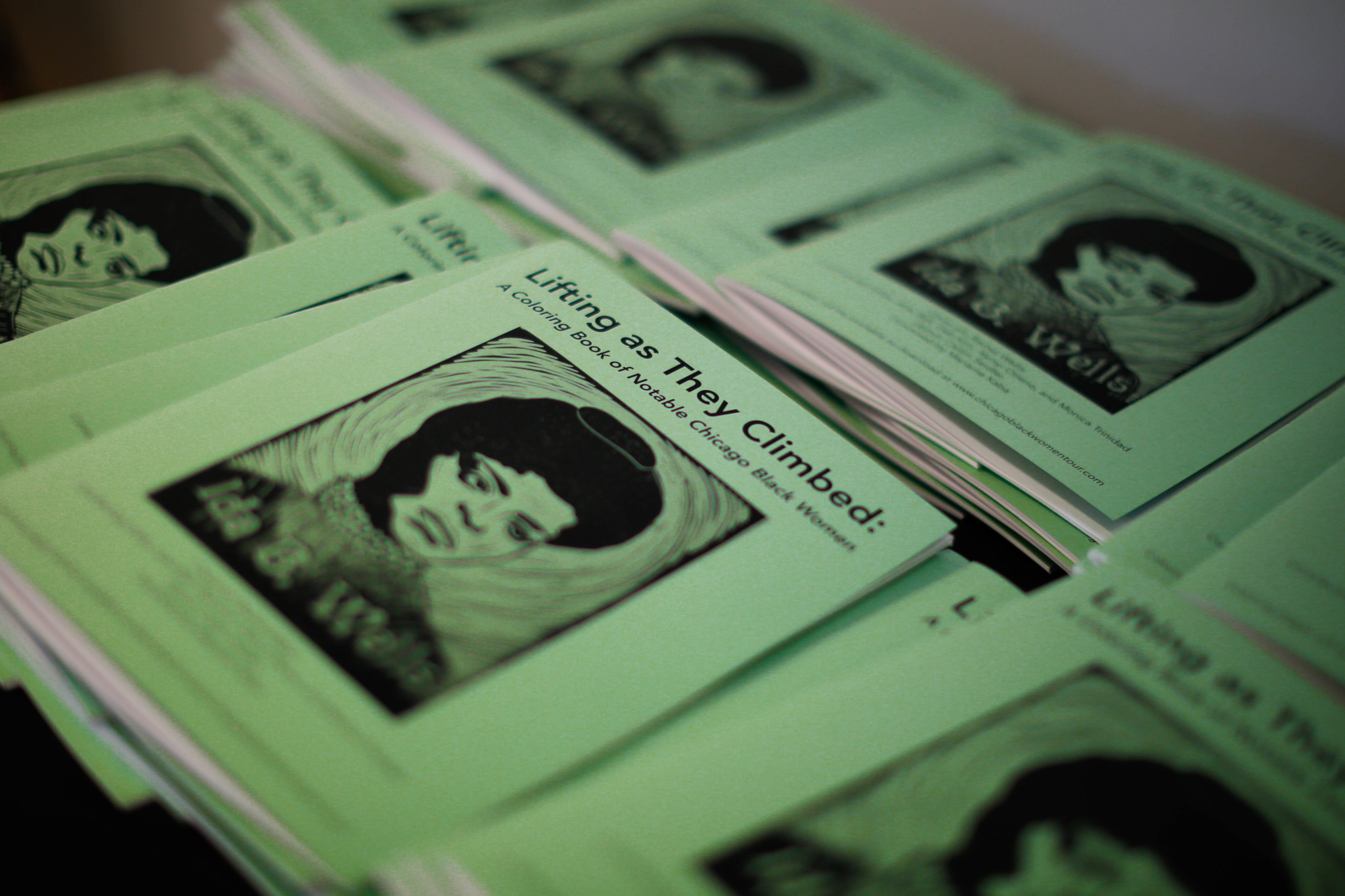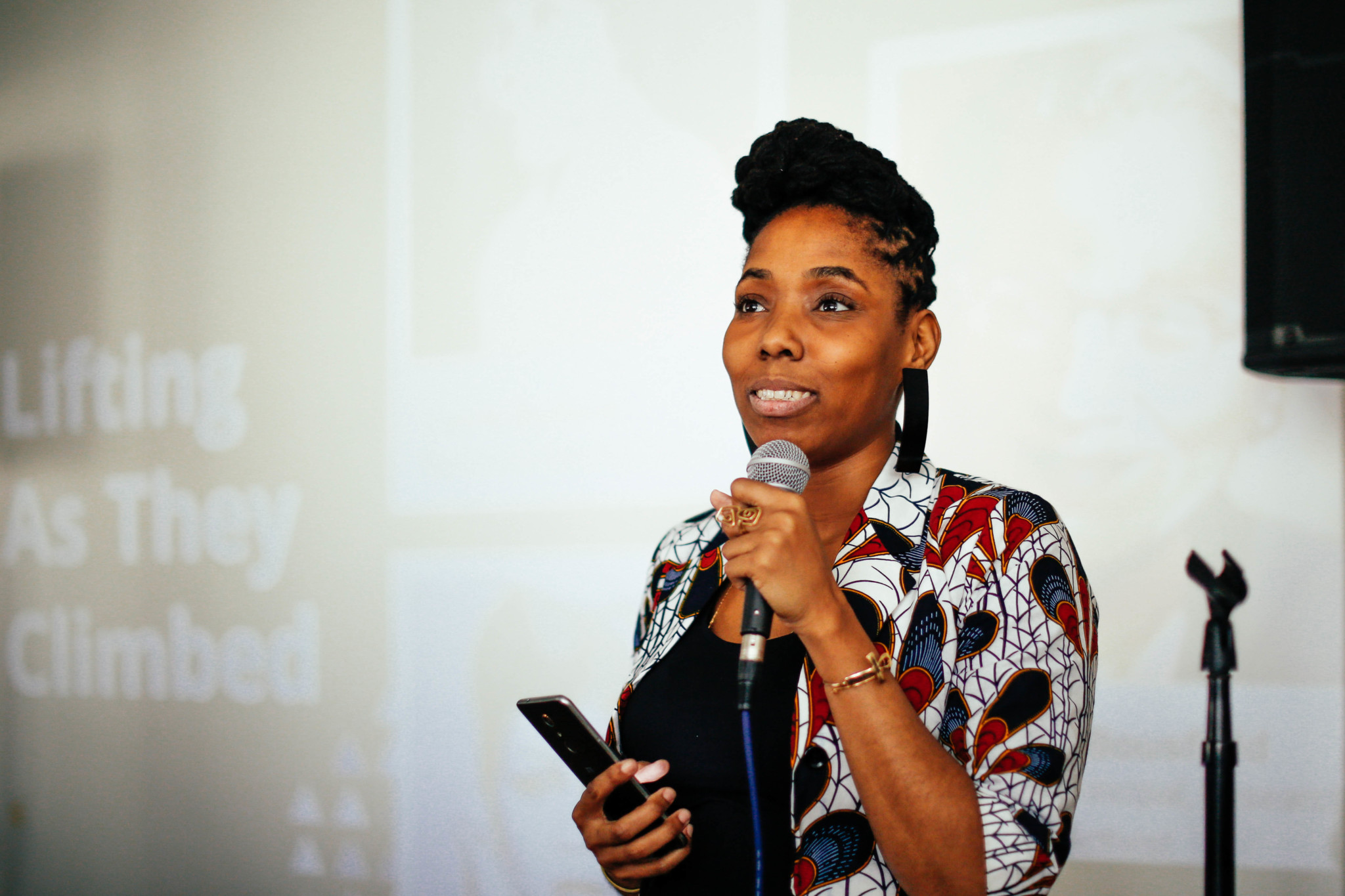All of my life I sat in history classes when we were young, and we didn’t see ourselves. No one ever handed me a book full of Black women, about Black women, by Black women, ever, in my public education.”
Activist and communications professional Essence McDowell was giving a welcome speech to the crowd gathered at the release party for the new guidebook she co-authored, Lifting As They Climbed: Mapping a History of Black Women on Chicago’s South Side. All around the packed, sunlit room at the University of Chicago’s Arts Incubator in Washington Park, audience members nodded along in recognition. “To be part of a project like this, it informed my present. It helped me understand what’s missing.”
The guidebook is a compilation of thirty-three main sites across the South Side (and ten additional sites of interest) that are linked to prominent Black women from the mid-19th century to today, and it works to fill in the histories McDowell found were missing in her education. The women featured had a wide range of vocations, from pilots to ministers to poets, and many were active in building their communities, creating institutions that still serve residents today.
McDowell and her coauthor Mariame Kaba—herself a Black woman with a long and respected legacy of activism in Chicago, though she is now based in New York—decided to format the book as a self-guided tour so that readers could feel more grounded within the history of their city. “It’s important to understand where you live, to be centered in that place, to understand everything that went into making that place the place you live in,” said Kaba. She said she especially hopes young Black women will be able to see their place in that history and understand themselves as “standing on the shoulders of people who came before them.”
The histories and work of most of the women in the book are not widely known, and even the authors had much to learn; when McDowell first joined the project, she was astonished to realize that she had never heard of most of the women Kaba had begun to uncover. At the time, McDowell was involved in several community organizing efforts, which she loved but also found emotionally exhausting. When Kaba, who had begun the project, wrote about it on Facebook seeking encouragement and assistance, her enthusiasm “about these women was just like a light went off for me,” McDowell recalled. As she learned, she felt uplifted and reinvigorated by their stories and compelled to help finish the project in any way she could.
McDowell was particularly impressed by the impact these women’s lives had on the city. “A lot of the women in the book came to Chicago in a time where there was no infrastructure to support Black life at all. And instead of being overwhelmed by… the fact that there were no support services, they literally were the solutions themselves,” she said. She was especially impressed by the life of Melissa Ann Elam, who was born into slavery but went on to found a home that supported working women and girls who moved north to Chicago during the Great Migration.
Support community journalism by donating to South Side Weekly
At the release party, Kaba spoke to the significance of highlighting these stories: “I think it’s really important in our culture right now, when there’s a lot of hashtags about Black girl magic and…how Black women are going to save the universe because of voting for the Democratic party, which is bullshit—we’re not saving the country, we’re actually trying to save ourselves,” she said. “People are doing what they need to do, like they’ve always done.”
“What I’d like people to do is actually take our intellectual labor, our contributions to history…our presence in the world seriously. And this book is an attempt to make that possible, so that it’s not a just surface-level, ‘Black women are great’ kind of situation, but like, know us, you know. Pay attention to what we’ve done in the world,” Kaba said. “I think in particular for us who are either so invisible-ized or hyper-visible, in really weird, distorted ways, I think for all of us to just be able to be ordinary and good as that in this culture is so incredibly important.”
The crowd that listened to Kaba and McDowell’s words at the release was in a celebratory mood, with people talking, laughing, and eating snacks. There was a display of books on Black women from Chicago, a button-making station, and a coloring station with free Lifting As They Climbed coloring books.

People of all ages were present, highlighting the continuity of the history in the guidebook through today. Kennie James, 86, who moved to Chicago during the Great Migration in 1936 and attended school with Ida B. Wells’s grandson, stopped by after reading about the event in the morning paper. She was surprised by the number and diversity of attendees, calling the event “magnificent.”
The next day, on a perfect blue-sky afternoon that felt like spring, thirty-five people joined a tour of a selection of sites from the book, guided by Kaba and McDowell. The group started in the Loop at Jones College Prep, where donated land for a public school in 1871. Then, the group boarded a bus and made its way south.
Participants visited the original printing site of the Chicago Defender newspaper, where Ethel L. Payne got her start as a reporter; Payne later became one of the first Black women to join the White House press corps. They explored the South Side Community Art Center, which was founded by Margaret Burroughs, an artist who taught at schools and prisons and also founded the DuSable Museum of African American History, then known as the Ebony Museum of Negro History and Arts. At Gwendolyn Brooks’s one-time home on 4259 S. King Drive, the group read “kitchenette building,” a poem Brooks wrote about the apartment complex.
The bus stopped down the street from Wells’s house to learn about the woman who sparked the idea for the guidebook in the first place. Kaba, who had sported a pair of earrings with a portrait of Wells the previous day, thought up Lifting As They Climbed while reading about her for another project. “While I was doing that research, it occurred to me that I never saw anything in terms of a tour that had been particularly focused on the histories of Black women in Chicago,” Kaba said, even though she “had been on other kinds of architecture tours, tours around gangsters and mobsters, those kinds of things.”
Wells is the person in the guidebook Kaba finds most fascinating. Wells “single-handedly put lynching on the map,” she said, but was exceedingly conservative in morals; she was a fearless journalist and activist, while also alienating allies who tried to work alongside her. In short, said Kaba, “She’s not perfect, and that’s what I love about her.”
Like the women in Lifting As They Climbed, and its authors, many of the many Black women who were present at the book release and bus tour were involved in their communities and working towards a vision of the future that they wished to see. One attendee of the bus tour, Maria Hadden, is running for alderman of the Far North Side 49th Ward. Alicia McGhee, a friend of the authors’, brought her five-year-old son to the book release. “It’s important for him to learn at an early age, and to see Black women in every position, authoritative and supportive,” McGhee said. McDowell is already looking ahead at a new project in her community. At the release she cited Fannie Barrier Williams, a woman who helped build many organizations that supported Black women, as inspiration to start an organization of her own for Black women in Chicago. There were cheers and applause. “I look forward to doing more work around Black women and girls,” said McDowell.


I, too, read about “Lifting as they Climbed” in the Saturday morning paper the day of the book party. Fortunately I made it to the opening book party and met Mariame Kaba and Essence McDowell. Kaba’s and McDowell’s book inspired me to celebrate the women, places and events of my youth. Their festive book party felt like a family reunion. I bought several copies of the book and gifted them to family and friends. I proudly and highly recommend reading “Lifting…” and taking the tours. Thanks, Kaba and McDowell for lifting our foremothers as they climbed in obscurity.
“Lifting as They Climbed” is a great read. Related tours of unsung African Americans’ homes in Chicago’s Bronzeville are a must-see.
This book sounds like a fascinating way to explore the South Side through the lives of prominent women who lived there. Thanks for writing about it!